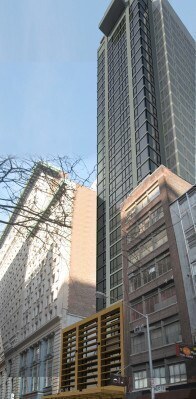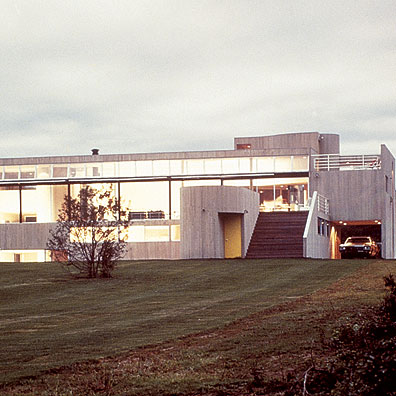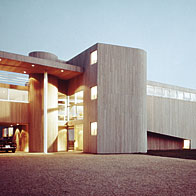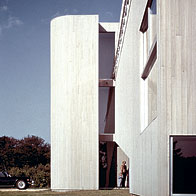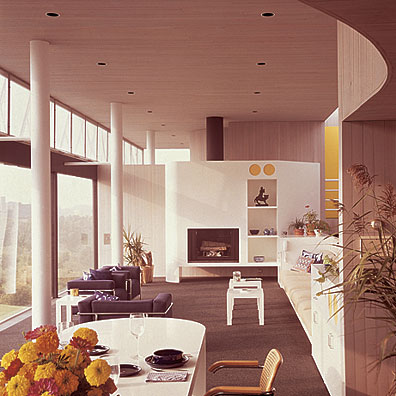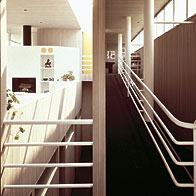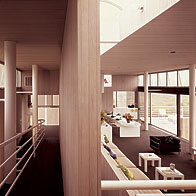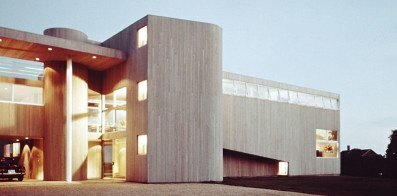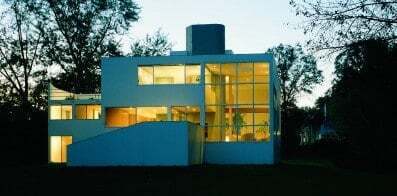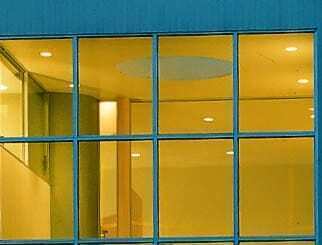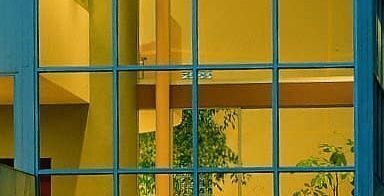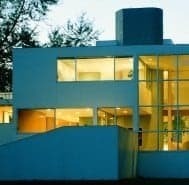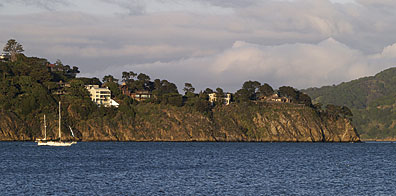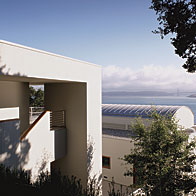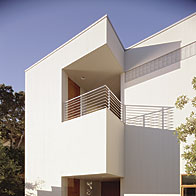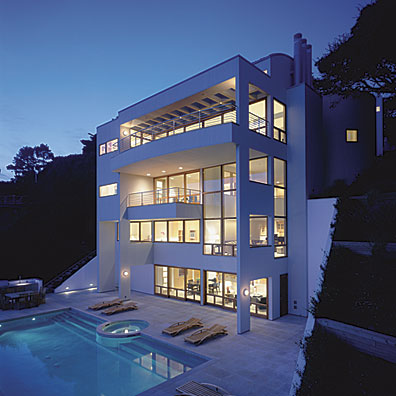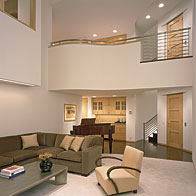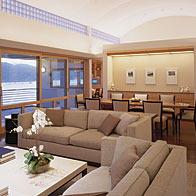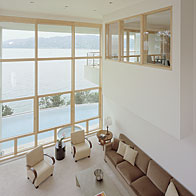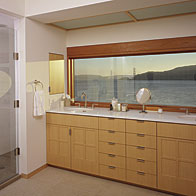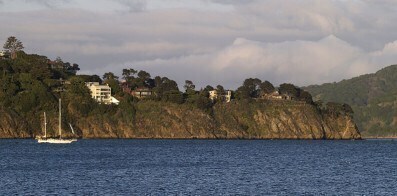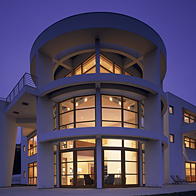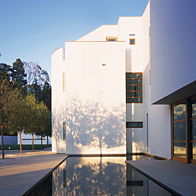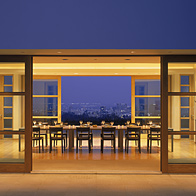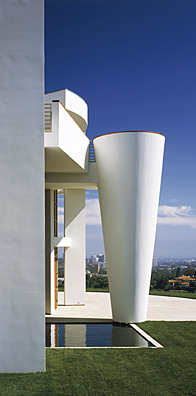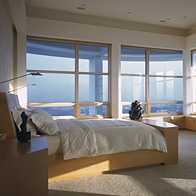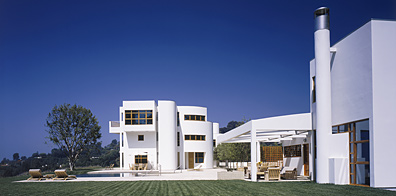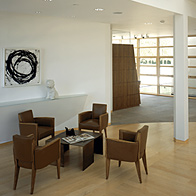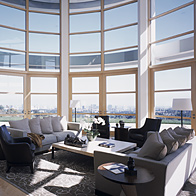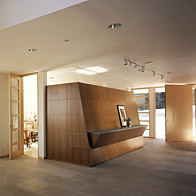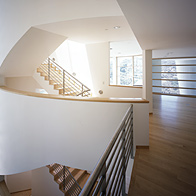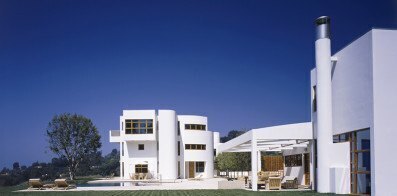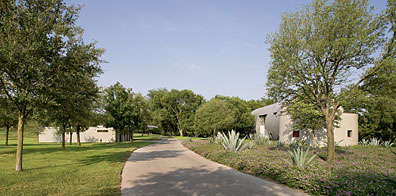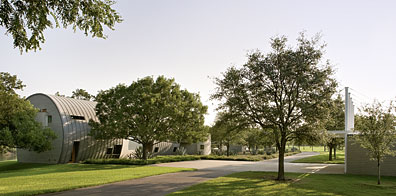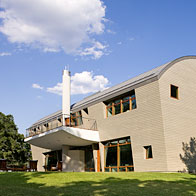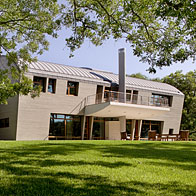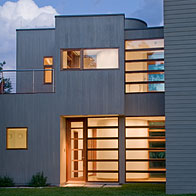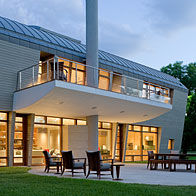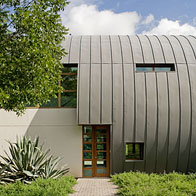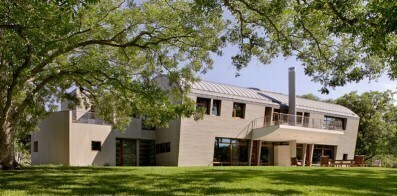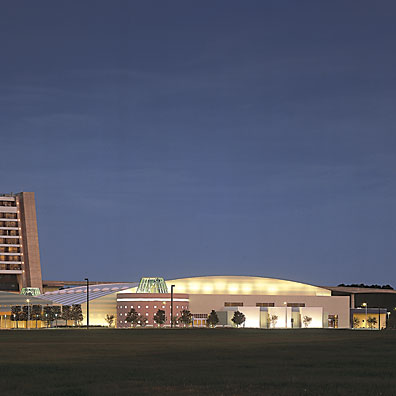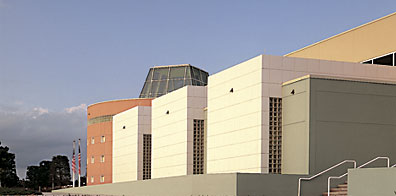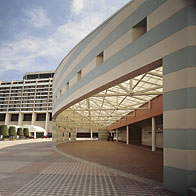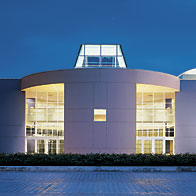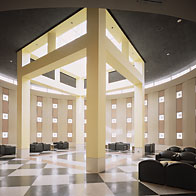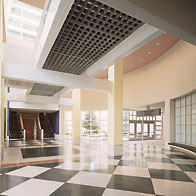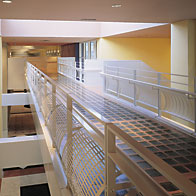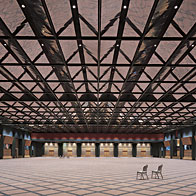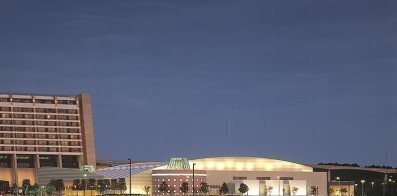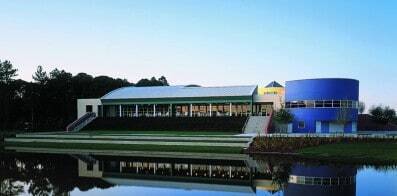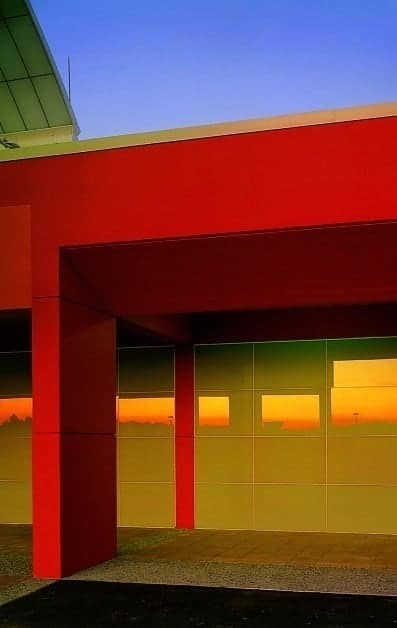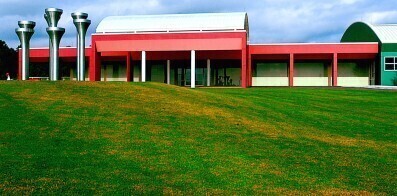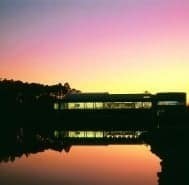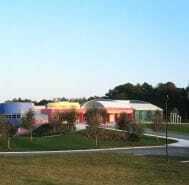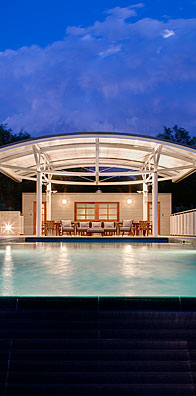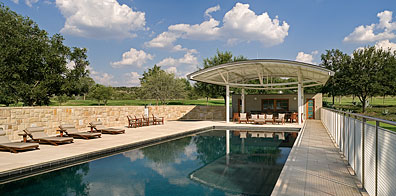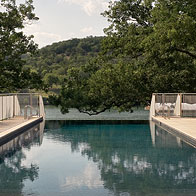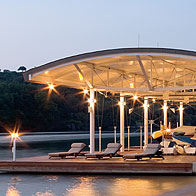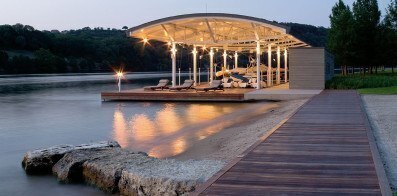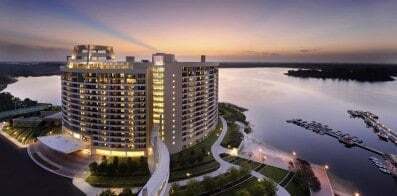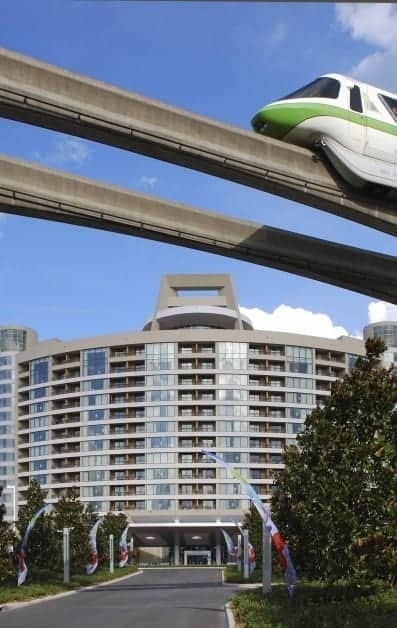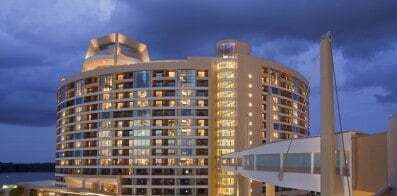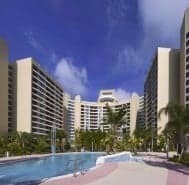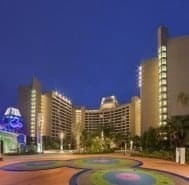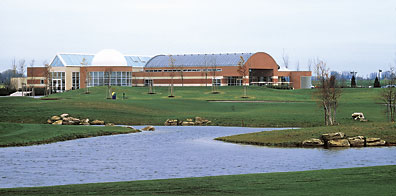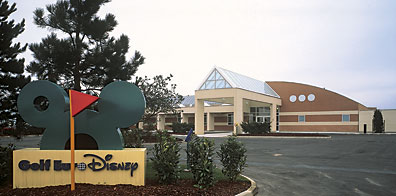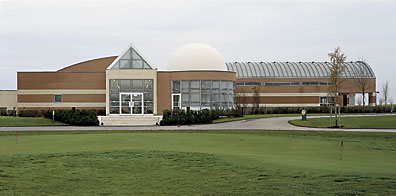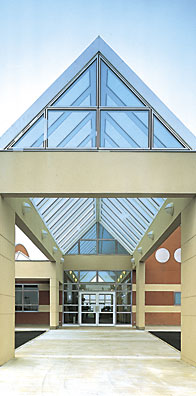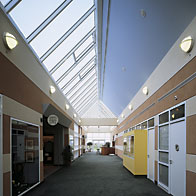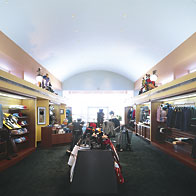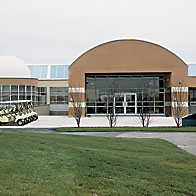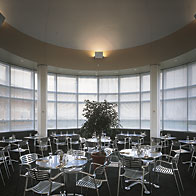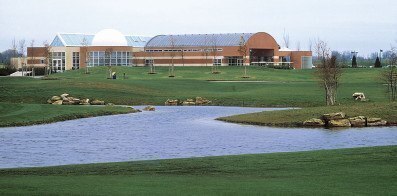Cogan Residence
East Hampton, NY The design of the Cogan residence responded simultaneously to the scale of the site—five acres with a pond on the south, and dunes and ocean beyond—as well as the scale of the program, which required a separate children’s zone, large living/dining space, kitchen, master bedroom and separate guest suite, staff bedroom, covered parking, outdoor storage, and swimming pool. Continue BackThe lower level is zoned by the entry, which separates automobile and service areas from the children’s zone. The entry permits direct access to the pool terrace and changing rooms and is the point of origin of a ramp, the primary circulation device for the house. The half-level landings and the linear circulation experience inherent in the ramp space develop multiple and sequential spatial and view experiences.
The first leg of the ramp parallels the children’s bedrooms, which with their doors and frosted glass interior clerestory windows, are articulated as outdoor entries. This sense of walking past the exterior of a building is heightened by the linear skylight two and a half stories over the children’s corridor and by the use of the cedar siding inside and out. The first landing arrives at the master bedroom, a modulated one- and two-story space. The second landing, above the entry and looking down through the entry portico, is the one-and-a-half-story primary living space with a large deck and outdoor stair extension. The third landing arrives at the study, a balcony over the master bedroom, with its own internal stair reconnecting it to the bedroom below.
The guest suite is reached separately, by a spiral stair from the main entry level, and has its own roof deck with views of the site, pond, and ocean. These multiple vertical circulation strategies contribute to the sectional complexity of the house. The half-level displacements create an overlapping section as complex and interlocked as the interaction between the pavilion frame and the object building.
Benenson Residence
Rye, NY
Belvedere Residence
Belvedere, CA The primarily vertical organization of this house takes advantage of its steeply sloped site on the southern coast of Belvedere, an island in San Francisco Bay. The four-story facade facing the water commands views across the bay towards the Golden Gate Bridge. The house’s compact organization ensures mutual privacy between it and its adjoining neighbors, and allows for dense vegetation. Continue BackAn exterior stair acts as the primary connecting device between the two wings of the house, and offers a visceral experience of the site’s steep gradient by producing a spatial “tension and release” between narrow, side yard spaces alongside the retaining walls, versus open spaces between outdoor “rooms.” An interior, circular stair winds around an elevator and forms the cylindrical focal point of the house’s massing.
A barrel-vaulted ceiling articulates the living and dining spaces at the topmost level of the main house, and a large deck projects towards the bay to extend the space into the landscape. Other, smaller projections from the house’s main volume towards the bay provide more intimate spaces for dining or leisure, producing a façade which can be read as a hierarchy of varying degrees of enclosure within the tripartite structural scheme. Bedrooms, a study and a two-story play area occupy the intermediate floors, while a gym of the lowest level offers close proximity to an outdoor terrace with lap pool, whose “infinity edge” of water establishes a poetic connection to the bay beyond.
The house’s exterior is clad in gray stained, vertical cedar siding, with a curved standing seam zinc roof. All exterior windows, doors and decks are teak. Exterior terraces are beige/gray flamed limestone pavers and the retaining walls are painted warm white stucco. Interior walls and ceiling are painted plaster; floors are limestone and wide plank, bubinga wood; woodwork and cabinets are lightly stained maple.
Bel Air Residence
Bel Air, CA The buildable site, an existing two-acre plateau, set sixty feet below the access road, affords panoramic views of Westwood, the Pacific Ocean, and the Canyon. The program, orientation, and topography provoked a composite courtyard parti that layers the site through the house, integrating the terraces and lawns. Continue BackThe sauna building/guest house, as well as the pool and terrace, are located on the eastern portion of the site, extending the outdoor spaces and completing the overall site building design strategy.
Compositionally and formally, this house presents the most articulated, hierarchical, and consolidated plan graphic to date, which is further reinforced by its volumetric resolution. The primary sculptural element is the reverse cone at the west end of the circulation spine that anchors and orients the house to its site, as well as to its primary interior spaces.
The massing and solid/void articulation is read as reductive, or the result of carving from an initial solid, rather than additive or assembled, giving the house a density and sculptural presence akin to the earliest beach houses
6D Ranch Lake House
Austin, TX This 6,380 square foot residence is sited on a large meadow on Lake Austin in Austin, Texas. The strategy was to design a modern reinterpretation of a Texas lake house “bungalow” for a family with four children. The program accommodates a living/dining/kitchen ground floor loft space opening to an outdoor terrace, facing and accessing the lake, as well as an adjacent, connected spa/exercise space. Continue BackMajor exterior materials include buff limestone paving, a translucent curved skylight, Alaskan white cedar siding, mahogany windows and doors and pre-weathered zinc standing seam roofing. The interior features polished concrete floors, mahogany doors and frames and maple cabinets.
Walt Disney World
Convention and Exhibition Center Lake Buena Vista, FL Disney World’s Convention and Exhibition Center represents a significant and independent addition to an existing complex of hotel and meeting facilities. The design must resolve its own, quite complex, program at the same time reconfiguring a composition of earlier buildings and public spaces and giving them a renewed vitality. The response was the design of a 2.5 acre entry plaza linking the old and new. Continue BackThe new addition contains a 45,000 square foot main ballroom that holds 3,300 people and can be divided into four multipurpose spaces: a 7,000 square foot ballroom, three prefunction galleries, five meeting rooms and a full-service kitchen with loading facilities.
Reinforced by a strong color palette, the Convention Center’s horizontal silhouette contrasts with the vertical, gridded facade of the Hotel. Four major forms create the collage-assemblage: the curvy, striped primary volume of the main ballroom and prefunction gallery; the entry canopy; and the two rotundas. One rotunda connects to the Hotel with stairs, escalators and a glass-block bridge; the other is accented by a square-punched window, an iconic form on the more visible west corner.
Walt Disney World
Bonnet Creek Golf Clubhouse
Lake Buena Vista, Florida
Unlike most Disney architecture, our buildings at Walt Disney World do not conform to the notion of theming. The “theme” of the Bonnet Creek Golf Clubhouse, as well as that of the Contemporary Resort Convention Center, is the architecture itself-the memory of forms and space, reinforced by color and graphics, establishing a primary sense of presence.
Sited on the knoll of a golf course overlooking a lake, the Clubhouse building is an object with a composite identity. Its silhouette, visible from a distance across the greens, is experienced more immediately through the vehicular arrival sequence.
The integrated use of color intensifies the multiple images and forms of a simple internal program: golf shop, bar and grill, banquet-multipurpose room, kitchen, lockers, administrative offices, maintenance facilities, golf-cart storage, and staff facilities. The goal was to transform the traditional golf clubhouse image into a site-responsive, architecturally defined object-collage in the landscape.
Bay Lake Tower at Disney’s Contemporary Resort Hotel
Bay Lake Tower Hotel Lake Buena Vista, FL Continue BackBay Lake Tower at Disney’s Contemporary Resort
Lake Buena Vista, Florida
The 470,000 gsf Contemporary Disney Vacation Club is sited on 13 lakefront acres adjacent to the Main Contemporary Resort Tower on the former North Garden building area. The 16-story hotel provides 266 two-bedroom suites, 124 of which can be converted into studio or one-bedrooms. 12 three-bedroom Grand Villas are located on the top floor. The Disney Vacation Club (DVC) is a unique alternative to the existing Disney Vacation properties, offering more luxurious, spacious and ‘home-like’ vacation rentals in a timeshare arrangement.
Overlooking Bay Lake, the site offers exclusive amenities for Vacation Club members, and shares facilities with the Contemporary Hotel. Guest amenities exclusive to the DVC tower include: a heated swimming pool and deck, volleyball and tennis courts, a playground, Main DVC entry, service entry, valet parking, and a covered walkway to the Hotel. Back of house spaces include administrative offices and cast facilities.
Public areas include a five-story Atrium Lobby with a dedicated Community Space for members’ functions and events. On the terrace level, a 1,200 square foot Member Living Room with DVC Information Center Desk provides additional open recreation space for members, along with a viewing terrace.
Similar to Gwathmey Siegel’s 1991 Disney World Convention and Exhibition Center addition to the Contemporary Resort development, the challenge in designing the Disney Vacation Club was to establish an exclusive, signature identity for the tower comparable in scale to the existing Contemporary Tower by Weldon Beckett.
The tower’s exterior walls are composed of sympathetic materials—stucco with a composite metal panel system—responding to both the original Contemporary Tower and Gwathmey Siegel’s earlier addition. Our design responds to the existing development, as well as the tower’s exclusive siting on Bay Lake. Every suite has a view of either the Lake or the Magic Kingdom. A Typical two-bedroom suite is 1200 square feet, with a full kitchen and other residential amenities.The new Vacation Club is the closet to the Magic Kingdom, and offers club members the opportunity to walk to the theme park or take the Tram from the Contemporary. The new property is a rising tower addition to the large Contemporary development, unique to the low-rise complexes typical of the area.
Euro Disney
Disney Golf Clubhouse Marne-la-Vallé, France EuroDisney’s Golf Clubhouse is initially experienced as an object on the horizon. Three distinct roof forms, a dome, a barrel vault and a curved, segmented shed, distinguish the primary programmatic volumes in contrast to the natural setting. Connecting the separate site and building circulation systems, the vehicular entry porch with a skylit canopy extends through the building as the public access gallery. Continue BackAssociate Architect: Rey-Grange and Jelensperger, RJ
